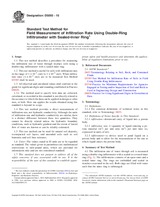Potřebujeme váš souhlas k využití jednotlivých dat, aby se vám mimo jiné mohly ukazovat informace týkající se vašich zájmů. Souhlas udělíte kliknutím na tlačítko „OK“.
ASTM D5093-15
Standard Test Method for Field Measurement of Infiltration Rate Using Double-Ring Infiltrometer with Sealed-Inner Ring
Automaticky přeložený název:
Standardní zkušební metoda pro zorné pole pro měření infiltrace Rate Pomocí Double -kroužek Infiltrometer s Sealed - Inner Ring
NORMA vydána dne 1.6.2015
Informace o normě:
Označení normy: ASTM D5093-15
Poznámka: NEPLATNÁ
Datum vydání normy: 1.6.2015
Kód zboží: NS-611282
Počet stran: 7
Přibližná hmotnost: 21 g (0.05 liber)
Země: Americká technická norma
Kategorie: Technické normy ASTM
Kategorie - podobné normy:
Anotace textu normy ASTM D5093-15 :
Keywords:
double ring infiltration, in-place infiltration, soil moisture infiltrometer ,, ICS Number Code 65.060.35 (Irrigation and drainage equipment)
Doplňující informace
| Significance and Use | ||||||||
|
5.1 This test method provides a means to measure low infiltration rates associated with fine-grained, clayey soils, and are in the range of 1 × 10−5 cm/s to 1 × 10−8 cm/s. 5.2 This test method is particularly useful for measuring liquid flow through soil moisture barriers such as compacted clay liner or covers used at waste disposal facilities, for canal and reservoir liners, for seepage blankets, and for amended soil liners such as those used for retention ponds or storage tanks. 5.3 The purpose of the sealed inner ring is to: (5.4 The purpose of the outer ring is to promote one-dimensional, vertical flow beneath the inner ring. The use of large diameter rings and large depths of embedments helps to ensure that flow is essentially one-dimensional. 5.5 This test method provides a means to measure infiltration rate over a relatively large area of soil. Tests on large volumes of soil can be more representative than tests on small volumes of soil. 5.6 The data obtained from this test method are most useful when the soil layer being tested has a uniform distribution of pore space, and when the density and degree of saturation and the hydraulic conductivity of the material underlying the soil layer are known. 5.7 Changes in water temperature can introduce significant error in the volume change measurements. Temperature changes will cause water to flow in or out of the inner ring due to expansion or contraction of the inner ring and the water contained within the inner ring. 5.8 The problem of temperature changes can be minimized by insulating the rings, by allowing enough flow to occur so that the amount of flow resulting from a temperature change is not significant compared to that due to infiltration, or by connecting and disconnecting the bag from the inner ring when the water in the inner ring is at the same temperature. 5.9 If the soil being tested will later be subjected to increased overburden stress, then the infiltration rate can be expected to decrease as the overburden stress increases. Laboratory hydraulic conductivity tests are recommended for studies of the influence of level of stress on the hydraulic properties of the soil. Note 1: The quality of the result produced by this standard
depends on the competence of the personnel performing it and the
suitability of the equipment and facilities being used. Agencies
that meet the criteria of Practice D3740 are generally considered capable of
competent and objective testing, sampling, inspection, etc. Users
of this standard are cautioned that compliance with Practice
D3740 does not in itself
ensure reliable results. Reliable results depend on many factors;
Practice D3740 provides a
means of evaluating some of those factors
|
||||||||
| 1. Scope | ||||||||
|
1.1 This test method describes a procedure for measuring the infiltration rate of water through in-place soils using a double-ring infiltrometer with a sealed inner ring. 1.2 This test method is useful for soils with infiltration rates in the range of 1 × 10−5 cm/s to 1 × 10−8 cm/s. When infiltration rates ≥1 × 10−5 cm/s are to be measured Test Method D3385 shall be used. 1.3 All observed and calculated values shall conform to the guide for significant digits and rounding established in Practice D6026. 1.3.1 The method used to specify how data are collected, calculated, or recorded in this standard is not directly related to the accuracy to which the data can be applied in design or other uses, or both. How one applies the results obtained using this standard is beyond its scope. 1.4 This test method provides a direct measurement of infiltration rate, not hydraulic conductivity. Although the units of infiltration rate and hydraulic conductivity are similar, there is a distinct difference between these two quantities. They cannot be directly related unless the hydraulic boundary conditions, such as hydraulic gradient and the extent of lateral flow of water are known or can be reliably estimated. 1.5 This test method can be used for natural soil deposits, recompacted soil layers, and amended soils such as soil bentonite and soil lime mixtures. 1.6 Units—The values stated in SI units are to be regarded as standard. The values given in parentheses are mathematical conversions to inch-pound units, which are provided for information only and are not considered standard. 1.7 This standard does not purport to address all of the safety concerns, if any, associated with its use. It is the responsibility of the user of this standard to establish appropriate safety and health practices and determine the applicability of regulatory limitations prior to use. |
||||||||
| 2. Referenced Documents | ||||||||
|




 Cookies
Cookies
